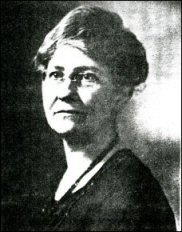|
 |
|
 |
Thursday, March 9, 1950
Other traffic consisted of horse-drawn "double wagons," buggies and "covered carriages," and also "buckboards." Later on in the century, rubber-tired equipped conveyances made their appearance, and were the last word in elegance around here. A high-stepping team hitched to the new carriages was not to be seen every day, and they were beautiful, too. There was something responsive and satisfying in horse-flesh that is lacking in the cold steel of an automobile. And one could have a real thrill when putting miles behind one in a buggy, while if one courted danger, let him try to drive a runaway team and get tipped over. And how the sand would fly, covering horse and driver with its unbeautifying dust. The maligned linen duster had its origin in the desire to protect one's person and garments from the flying particles of dirt while driving behind a horse or horses. The last linen duster I saw was in a church rummage sale, and I purchased it for the magnificent pearl buttons with which it was adorned. It cost me twenty cents. Such are the fleeting values of human things.
But I have always missed the merry jingle of sleigh-bells in the winter. How cheering was their music on a zipping cold day in January, and how suggestive of the fun and frolics of youth. Their owners cared not for icy roads nor fumed if they were unsanded, for Doblin was "sharp shod" and used to North Country highways. Must have been cold, what? You, of course, are comparing the old "rigs" with your new, heated automobile. Of course a horse-drawn equipage is somewhat chilly in the winter, but folks knew of no other way of getting around, and hot bricks, many buffalo robed, and a sublime ignorance of what comforts awaited them in the future made them impervious to their deprivations. Another thing. Here in Parishville, nine miles from Potsdam, folks expected to stay at home the greater part of the time. Such a trip to be taken every day, sometimes more than once a day, was out of the question. Snows in winter often completely isolated Northern villages, and the tiresome journey over the mud or sand of summer was equally hard. And their work was mostly unrelieved by modern use of electricity. So they stayed at home. There were the kerosene lamps to clean and fill, and stoves to polish. The soiled linen to be cleaned by means of the wooden tub and wash-board, and ironed with iron flat-irons heated on the hot stove. They still used carpets in 1900 and they had to be swept with a broom, and once a year they had to be taken up and beaten out of doors, then taken back in stretched and tacked down again. In the majority of homes, although having bare floors, rugs sometimes came into use.
Much of the perishable food was carried down cellar after each meal and brought up again for the next one. Garden vegetables were canned or dried, not frozen. Fuel had hourly to be stuffed into the hungry maw of numerous stoves. One could buy some food, but the meat trucks delivering every other kind of cooked food had not arrived in great numbers. So the house-wife had her never-ending baking days over the hot stove, although Perfection oil stoves became quite common shortly after 1900. I remember Miss Eva Clapp's fireless cooker, which she considered the answer to her culinary interests. Always abreast of her times, she installed a wood furnace in her ancestral home at least forty years ago. Men's work was also more onerous . . . [missing text] . . . mowing machines were not a great novelty. But many years passed before tractors performed the work of humans entirely. As "hired men" and "hired girls" faded out of the picture, machinery took their places. Or did machinery crowd out the necessity of dependence on man-power to do the work? At any rate, the American genius for inventing new contraptions has revolutionized life in all respects, both indoors and out.
Fifty years ago also, the house-wife "did up her sewing" at stated times, and that kept her from rambling around much. How well I remember the earnest attacks on yards of "bleached" and "unbleached" cotton during the months of January and February. The sheets which were sewed "over and over" by hand down the middle seam, the pillow slips often trimmed with hand-made lace. The voluminous petticoats, the "corset covers," shirt-waists and dresses, and most of the children's garments were made at home. Table-linens were hemstitched. Rags were sewed for carpets and rugs. Many women made shirts and even trousers for their men folks besides a great amount of knitting which they found time to do.
|